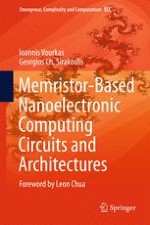2016 | OriginalPaper | Buchkapitel
4. Memristor-Based Logic Circuits
verfasst von : Ioannis Vourkas, Georgios Ch. Sirakoulis
Erschienen in: Memristor-Based Nanoelectronic Computing Circuits and Architectures
Aktivieren Sie unsere intelligente Suche, um passende Fachinhalte oder Patente zu finden.
Wählen Sie Textabschnitte aus um mit Künstlicher Intelligenz passenden Patente zu finden. powered by
Markieren Sie Textabschnitte, um KI-gestützt weitere passende Inhalte zu finden. powered by
